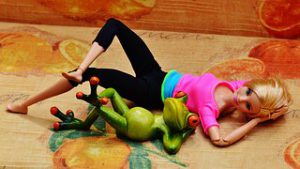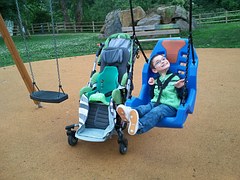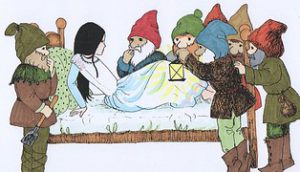Age-appropriateness is a hallmark of our modern special education system, and in some ways, rightfully so. This well-intentioned policy was designed to ensure that teachers challenged children to reach their fullest potential, rather than assuming and teaching to their perceived limitations. That we didn’t talk baby-talk to them and set them in front of a Barney video with a teddy bear in one hand and a handful of Gummy Bears in the other.
It’s important that we take care to treat our special needs students with the dignity and respect befitting people of their age rather than treating them like infants. And it’s true that, when we raise our expectations, children often blossom.
However, it’s also possible to take this idea too far. Under the guise of “age-appropriateness,” I’ve seen students forbidden to hug anyone but immediate family (and in some cases, even they are greeted with a handshake), forbidden to engage in any self-stimulating activity, and forbidden to play with toys or engage in activities designed for younger children.
Some educators insist that a high school special education student work only 1,000-piece puzzles, although his skill level demands thirty-two pieces or less; that he may “look at” adult magazines, but not read picture books; and that he must give up Legos, blocks, and Matchbox cars, even if his mental age is equal to that of a five-year-old. In short, he must give up the things that bring him joy.
Which leads me to Lisa’s story
 Lisa loved rainbows. If she could have poured milk over a rainbow and eaten it, she would have. She also loved glitter, flowers, balloons, bubbles, and brightly-colored folders with foil designs. But mostly, more than anything in all the world, it seemed, she loved circles. Buttons, balls, the sticky paper circles used to reinforce the holes in notebook paper. If it was shaped like a circle, Lisa loved it.
Lisa loved rainbows. If she could have poured milk over a rainbow and eaten it, she would have. She also loved glitter, flowers, balloons, bubbles, and brightly-colored folders with foil designs. But mostly, more than anything in all the world, it seemed, she loved circles. Buttons, balls, the sticky paper circles used to reinforce the holes in notebook paper. If it was shaped like a circle, Lisa loved it.

The year I had her in my special education class, she was a dark-haired, fair-skinned beauty with sparkling eyes the color of hibiscus. She danced through that school year as joyful as a hummingbird, her pleasure in a playground filled with dandelions infectious and undiluted.

Among Lisa’s favorite objects were the one-inch cylindrical beads we used to increase eye-hand coordination and patterning. They came in a variety of bright colors and, most wondrous of all, the cylindrical shape resulted in a perfect circle at each end. We gave her a shirt box full of them and made a deal. As long as she did her work and followed the rules, she could keep them on her desk; she could carry them in her pockets; she could have as many beautiful, wonderful circles as her heart desired.

As the year progressed, Lisa learned to read. She learned beginning addition. She learned to control her temper (for though her temperament was basically sunny, she could throw a truly awe-inspiring tantrum). She learned how to admire another child’s balloon without confiscating it for her own.
“Oooh,” she’d coo to herself. “Pretty balloon. Not yours. Not yours. Can’t have it.”

There were some who advised against indulging her passions. “She’s becoming too dependent on these circles,” one teacher said.
“She has to learn to be like everyone else,” said another.
Instead, an interesting thing happened. With so many circles so readily available, they began to lose their irresistible lure. She still enjoyed looking at the beads on occasion, and for many months, she carried a yellow one in her pocket; but by the end of February, she was no more interested in them than any other student.
She left us the next year. Through reports from other teachers, I kept up with her progress. I was told she was doing well. Ms. Sherry, my assistant, and I spoke wistfully of the joy she had brought into our classroom.
Several years later, we met her current teacher, who assured us that Lisa was making excellent progress.
“That’s wonderful,” I said. “Does she still love rainbows like she used to? Does she still love flowers?”
“Oh no,” said the other woman, disdainfully. “We’ve gotten her out of all that.”
My heart sank. What a shame, I thought. Not only that you’ve stolen her joy, but that you should be so proud of it.

Some years later still, I met Lisa again. She sat at her big desk at the Junior High School, peeking surreptitiously into a notebook she had hidden in the crook of her arm.
“What are you looking at?” I asked, and she snapped the book shut, biting her lip, cheeks flushing.
“It’s all right to show me,” I said, gently. “I’d really like to see it.”
“You’ll be mad at me,” she said, but finally, reluctantly, she opened the notebook to reveal a glittery birthday card covered with brilliant flowers and delicate, curling rainbows.
“Oh, Lisa,” I breathed, glad that that her last teacher had not, indeed, ‘gotten her out of all that’. “It’s beautiful.”
Eyes downcast, she whispered, “Please don’t tell my mother.”
The “Age-Appropriate” Movement: Well-Intentioned but Often Misused
Lisa had fallen prey to a misguided application of the ideology of “age-appropriateness.
When I first mentioned my concerns about this practice, I was told that: a) cognitively impaired children can’t distinguish between appropriate and inappropriate times for a given behavior; thus, all such questionable behaviors must be banned entirely; b) some behaviors that are acceptable for “normal” individuals appear more bizarre in someone with cognitive impairments; and c) children with cognitive impairments must learn to act like everybody else.
Yet, a 17-year-old with an IQ of 40 cannot behave exactly like a 17-year-old with an IQ of 125. Typically, he can’t read young adult novels, work adult-oriented crosswords, or play complex games of strategy. He can’t get into his own (or his parents’) car and drive himself to a movie theater. He can’t go alone to a party and carry on an intellectual conversation with a person of the opposite sex. He’s bored by books without pictures, television shows with more dialogue than action, and puzzles with too many pieces. His joy might come from simpler things, from music and modeling clay, cartoons and coloring books.
And there is nothing wrong with that!
I thought I was alone in this sentiment until I spoke with Ruth Sullivan, who at the time was Director of Autism Services for Huntington and Charleston, WV. As we shared our various experiences in special education, I lamented that educators so often “train” children with autism and cognitive delays by forbidding them the very things they enjoy most.
Her eyes lit up. “I feel exactly the same way,” she said. “Do you know there are programs where they refuse to let the autistic children listen to music because they love it too much? They say it gets the children too excited.”
If that’s not heartbreaking, I don’t know what is.
In six years of college and twelve years of teaching, I have never been offered a class or an inservice on preserving my students’ natural delight in the world around them. But that does not mean these things are unimportant.
Five Questions
Kate Ahern, whose website, Teaching Learners with Multiple Special Needs, suggests an approach that replaces the concept of age-appropriateness with what she calls age-respectfulness. I was thrilled to come across it, because it so beautifully expressed my belief that we can treat our special population with respect without taking away the things that give them the most pleasure.
Over the years, I discovered five questions that helped me decide how to handle a child’s younger-than-his-years interests and behavior should be .
1) Is the behavior or attitude harmful or disruptive?
If it is, the behavior must be stopped, the attitude changed. But if the behavior harms no one and can be made unobtrusive, why not permit it? Lisa’s desire to carry a one-inch bead in her pocket, for instance, was both discreet and harmless. She could have continued it until she was eighty and no one would have been the wiser.
2) Is the behavior really inappropriate, and if so, can it be made more age appropriate?
A common practice among “age appropriate only” advocates is preventing teenagers and adults with cognitive disabilities from playing with dolls. However, many intelligent adults engage in this very same activity. Many Barbie doll collectors enjoy dressing and undressing their dolls. Some even buy two of each doll—one to exhibit and one to play with!

Here are some other examples.
- Before his passions for hiking and photography subsumed all other interests, my husband, whose intelligence quotient is somewhere near stratospheric, collected and assembled model race cars. On Saturdays, he and his friends played elaborate war games with carefully painted miniature soldiers, ships, tanks, and planes.
- There are clubs all across the country for men and women with a passion for model trains.
- One woman I know collects snow globes and became quite upset when her family and co-workers informed her that they refused to buy her any more because she

photo from http://www1.macys.com/ “already had enough”. “Who are they to tell me I have enough?” she fumed. “That’s not for them to say!”
- Another friend received an unexpected gift from her 16-year-old daughter—a stretchable, glow-in-the-dark Alien Autopsy doll and some glow-in-the-dark star stickers. “You could put those on your ceiling,” one of her guests joked, and she laughed, “No, I’m going to put them on me!”
- Several artists I know enjoy browsing through the children’s section of local bookstores and libraries. They say the artwork is incredible.
- Some of us are still moved to tears by stories like The Velveteen Rabbit and The Giving Tree.
- Georgia O’Keefe, like Lisa, had a passion for flowers. If she had been forbidden to explore that passion, what kind of art would she have created? Would she have created art at all?
Let’s not deny our exceptional students these same pleasures. If she loves dolls, buy  her some and call it a collection. If he loves Star Wars, let him “collect” action figures and other memorabilia. Almost anything a child enjoys can be presented in a socially acceptable manner.
her some and call it a collection. If he loves Star Wars, let him “collect” action figures and other memorabilia. Almost anything a child enjoys can be presented in a socially acceptable manner.
3) How can the behavior or passion be made more socially acceptable?
Jeremy’s self-stimulating behavior of thumping his chest was disruptive and drew negative attention in public. We were able to redirect the behavior by asking him to drum on his thighs instead. In time, he learned to engage in it only at appropriate times, such as when music was playing in a setting where his drumming would not disturb others.
As for the issue of toys: all but the most severely cognitively disabled children can learn that the doll can be played with at home or in the car, but may not be taken into the restaurant. Most can learn to save their hugs for people they know well and love and give handshakes to everyone else.
It is simply not necessary to forbid all displays of affection. If you’re consistent in your enforcement of the rules (“You may hug Mommy and Daddy and Uncle Henry and Miss Johnson, but you may not hug people you don’t know”), they will learn the rules and the exceptions.
4) How can I use the child’s interest to encourage or teach desirable skills or behaviors?
Lisa willingly curtailed her tantrums and her desire to roam around the room in return for her beloved circles.
Hunter performed his detested math sheet for a promise of 10 minutes of computer time.
Paul sat quietly through an assembly (which he hated) if he knew I would read his favorite book to him when it was over.
Tiffany worked diligently on a vocational activity, knowing that a music class would follow. Many exceptional children love music, and even those who are normally unresponsive may begin to interact and use eye contact during music time. The child who becomes over-stimulated by music can be exposed to music for brief periods that end when he shows signs of being overexcited. The time is increased by small increments over a span of several days or weeks, until the child can listen to music without losing control.
5) What can I appreciate and enjoy about this child?
 I suppose this question isn’t exactly about whether or not to encourage a specific behavior, but it was an important reminder to appreciate each child as an individual–to find, even in the most difficult students, something to love.
I suppose this question isn’t exactly about whether or not to encourage a specific behavior, but it was an important reminder to appreciate each child as an individual–to find, even in the most difficult students, something to love.
Early in my teaching career, I was on the playground with a group of “regular ed” teachers who began to discuss the comprehensive development children.
“It’s such a shame,” said one.
Another shook her head. “I couldn’t do it. It would make me so depressed, I would just come home every day and cry.”
“Wouldn’t it be nice,” offered a third, “if there were no more handicapped children?”
 I thought about this, and finally I said, “Well, I agree it would be great if no child ever had to have a disability. But since they’re here, why can’t we just enjoy them?”
I thought about this, and finally I said, “Well, I agree it would be great if no child ever had to have a disability. But since they’re here, why can’t we just enjoy them?”
They looked at me as if I had uttered a blasphemy, but I stand by my statement. Because I have enjoyed them. There was Amy, who would brush my hair until it stood straight up like the quills of a porcupine. “Oh, Miss Beth,” she’d giggle. “You look silly.”
There was Lena, who loved the “Peanut Butter” song. Michael, who sang Michael Jackson tunes into his forefinger as if it were a microphone. Jeremy, who loved Martin Luther King. (“We have to be quiet in the hallway,” I told him once, and he answered, “But Miss Beth, I have a dream!”)
There was Derek, who told the story of Snow White so beautifully that one of my greatest regrets is never having captured it on videotape. We had him tell it several times each year, and each time it grew more and more elaborate. By the time he left us (after 5 years), it had become a production.
“Come on, dwarfs,” he’d say, beckoning the other children from their seats. “Hi ho, hi ho,” he’d make them sing, and send them off to the “diamond mines”. In my role as Snow White, I would look at the invisible apple in his outstretched palm as he intoned, “I have for you the poiiiiii-son apple. Eat it!”
Those children made so many precious memories; memories that enriched their lives and the lives of everyone who knew them. (A university professor observing one of my student teachers once said of Jeremy, “I know we shouldn’t encourage him, but he’s delightful.”)
If he’s delightful, why shouldn’t we encourage him?
Lisa still loves flowers. She still craves rainbows and bubbles and bright shiny folders with foil designs. She still loves beauty. She still loves balloons.
I only hope that one day she won’t have to be ashamed to show it.



This was such a wonderful and emotional read for me. I couldn’t agree with you more. This really hits home because my mother and all 3 sisters are special education teachers and I know for a fact that they share the same beliefs as you do when it comes to “age-appropriateness” and how it can be taken too far. I will be sharing with each of them this article and I know you will have 4 new supporters. Thank you for getting this information out there and keep up the great work.
Patrick
Thank you so much, Patrick. I hope your mother and sisters will come here and share some of their favorite memories with us. Over time, I plan to add a lot of teaching activities and free, downloadable materials and patterns for teachers, so hopefully they’ll find some things they can use in their classrooms.